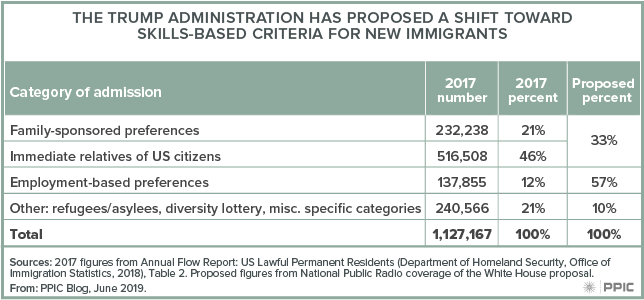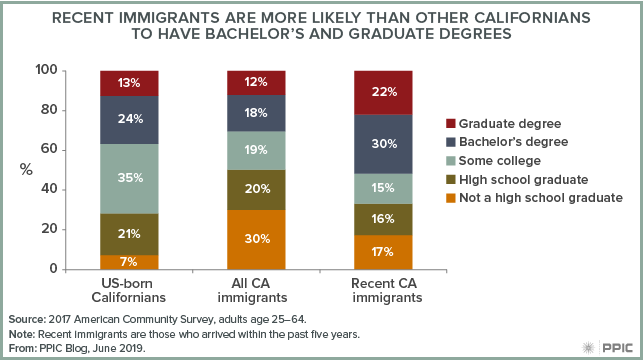The White House recently issued a summary of an immigration plan that would shift the nation’s largely family-based immigration system toward a skills-based approach that would probably prioritize immigrants with higher levels of formal education. Given that the education levels of new immigrants are already on the rise, what impact might a skills-based system have on in California, the state with the largest immigrant population?
The proposed new system would increase the percentage of skills-based legal immigrants from 12% to 57%, leaving the total number of immigrants at 1.1 million per year.

In recent years, about two-thirds of immigrants with lawful permanent residence status (or “Green Cards”) have been admitted to the US through family-based preferences. The proposed new system would reduce this by half, to 33%. The White House statement emphasizes that priority would still be given to immediate family members of both US citizens and lawful permanent residents.
Past PPIC research suggests that family-preference immigrants have historically been high- and low-skilled. And California’s economy relies on immigrants at both ends of the educational spectrum. Nearly a third of the state’s working-age immigrants lack a high school diploma, and they make up a large portion of the workforce in industries requiring less formal education. However, the foreign-born now constitute 31% of California workers who have at least a BA, and they are overrepresented in high-skill industries like technology and health care.
Recent PPIC research finds that new immigrants in California are increasingly well-educated. In 2017, a slight majority (52%) of the state’s working-age immigrants with fewer than five years in the US had a bachelor’s or graduate degree, compared to only 22% in 1990. Only 17% had not graduated from high school, down from 47% in 1990. Indeed, recently arrived immigrants are more likely than US-born Californians to have college or graduate degrees.

It is impossible to know exactly how a skills-based immigration system would affect California. But given the trend toward higher education levels among new immigrants and state economy’s reliance on both high- and low-skilled workers, a shift toward such a system might not be necessary to meet California’s workforce needs.




